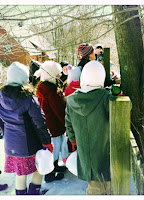 On Tuesday we invited a bunch of our homeschooling friends over to try our hand at maple sugaring on our farm. Thanks to Phyllis and Laurel for taking the photos and sharing them with me!
On Tuesday we invited a bunch of our homeschooling friends over to try our hand at maple sugaring on our farm. Thanks to Phyllis and Laurel for taking the photos and sharing them with me!First, we identified the sorts of trees we have, and which ones could be tapped for producing maple syrup. (Here we're looking at a Red Maple -- we tapped both the Reds and, of course, the Sugar Maples, to make sure we got enough sap to ultimately produce enough syrup for all the families involved to have enough for at least one pancake meal.) We measured the trees to determine how many taps to put in them. If the tree was under 12 inches, it was too small to tap (it still needs all it's sap for growing). If the tree was over 12 inches, we placed one tap. If it was over 18 inches, we placed two. And our one ancient old sugar maple we placed three taps in, because it's well over 26 inches.
 Since I'm more interested in preserving the health of our trees than I am in providing a completely authentic colonial experience, I used a power drill rather than a hand brace to make the smallest, cleanest holes possible.
Since I'm more interested in preserving the health of our trees than I am in providing a completely authentic colonial experience, I used a power drill rather than a hand brace to make the smallest, cleanest holes possible. Then the kids tapped in the spiles. Each child got to establish one tap -- in total we put in 9 metal spiles and 4 homemade wooden spiles.
Then the kids tapped in the spiles. Each child got to establish one tap -- in total we put in 9 metal spiles and 4 homemade wooden spiles. Mmmmmm, sweet water right from a Sugar Maple tree!
Mmmmmm, sweet water right from a Sugar Maple tree! The wooden spiles required a much larger hole (and a bit of ingenuity in holding the collection containers), so we placed them in a large multi-trunked Red Maple that I care a bit less about than our Sugar Maples.
The wooden spiles required a much larger hole (and a bit of ingenuity in holding the collection containers), so we placed them in a large multi-trunked Red Maple that I care a bit less about than our Sugar Maples. Then we hung our containers -- mostly plastic milk or juice jugs, but in a few cases we used metal dog buckets when we just couldn't get anything else to work.
Then we hung our containers -- mostly plastic milk or juice jugs, but in a few cases we used metal dog buckets when we just couldn't get anything else to work.Then our friend went home and we sat back and waited for the sap to fill our containers!
I also read my kids the book Maple Moon, by Connie Brummel Brook and Scott Cameron (which is a fictional accounting of the discovery of maple sugaring by a Native American boy), just to establish a connection with Native American cultures in this unit that is a precursor to our big Haudenosaunee cultural unit.






No comments:
Post a Comment